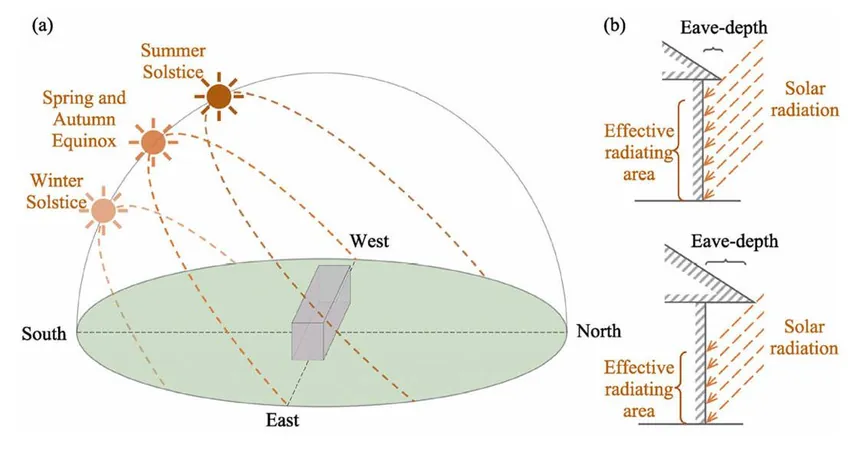
Climate Change: The Hidden Force Behind Ancient Chinese Architectural Evolution
2025-08-16
Author: Arjun
Revealing the Link Between Climate and Architecture
In a groundbreaking study, researchers have unveiled the intriguing "Six Dynasties Bracket Mystery"—a puzzle surrounding the sudden disappearance of projecting arms in ancient Chinese architectural designs. By examining about 250 archaeological sites paired with paleoclimate data, the researchers have linked this architectural transformation to climate shifts that occurred between the 3rd and 6th centuries.
From Aesthetics to Adaptation
Traditionally, the change in design was viewed through the lens of artistic or technological advancements. However, this new research positions ancient Chinese architecture as a fluid system, intricately attuned to environmental pressures. As climate changes unfolded, architectural choices adapted, revealing a fascinating intersection between design and climate resilience.
Ancient Civilizations and Climate Influence
Throughout history, climate change has shaped civilizations, from the droughts of the Mayans to the collapse of Norse settlements. Yet, the everyday ramifications of these shifts—such as the impact on architectural styles—have often gone unnoticed. In China, wooden and earthen structures were designed to harmonize with their surroundings. The iconic dougong bracket sets, known for their deep eaves, served to shield buildings from sun and rain.
A Focused Investigation
The team from the Chinese Academy of Sciences, in their peer-reviewed study published in the Journal of Geographical Sciences, offers the first quantitative insight into why projecting arms faded from these designs during a period of climatic upheaval. Analyzing artifacts dating from the 1st to 8th centuries, they observed significant declines in projecting arms during two distinct cold and dry phases.
Data-Driven Discovery
Their study revealed how fluctuating climate conditions diminished rainfall and intensified winters, rendering traditional deep eaves less effective for protection and more of an obstruction for sunlight in colder months. By utilizing solar exposure models, the researchers showed that reducing eave depth could increase sunlight by up to 35% during winter, aiding in passive heating—a crucial survival strategy.
Architectural Evolution as Survival Mechanism
The timing of these architectural changes was not random; statistical analyses confirmed a clear correlation with climate shifts. This evolution wasn’t merely an aesthetic choice, but a strategic adaptation to an increasingly harsh environment. As conditions warmed again, projecting arms saw a revival, highlighting the cyclical nature of architectural evolution influenced by climate.
Lessons from the Past for the Future
Dr. Li Siyang emphasizes that these findings illustrate the ingenuity of ancient builders, stating, "This isn't just about lost craftsmanship—it’s a tale of climate resilience. Our ancestors were not passive; they actively engineered solutions to survive. By deciphering their architectural logic, we can understand how design can effectively respond to environmental challenges."
An Echo of Sustainability in Modern Architecture
With climate change increasingly impacting contemporary life, ancient strategies present valuable lessons for sustainable architecture today. The redesigns of bracket sets align with modern pursuits of carbon neutrality and eco-friendly designs in initiatives like China’s "Beautiful China Initiative." By merging traditional wisdom with cutting-edge technologies, architects can create buildings that are not only functional but also harmoniously adapted to their climate.
This exploration into the ancient past demonstrates that history is not just a record to be studied, but a treasure trove of knowledge from which we can draw inspiration for the future.


 Brasil (PT)
Brasil (PT)
 Canada (EN)
Canada (EN)
 Chile (ES)
Chile (ES)
 Česko (CS)
Česko (CS)
 대한민국 (KO)
대한민국 (KO)
 España (ES)
España (ES)
 France (FR)
France (FR)
 Hong Kong (EN)
Hong Kong (EN)
 Italia (IT)
Italia (IT)
 日本 (JA)
日本 (JA)
 Magyarország (HU)
Magyarország (HU)
 Norge (NO)
Norge (NO)
 Polska (PL)
Polska (PL)
 Schweiz (DE)
Schweiz (DE)
 Singapore (EN)
Singapore (EN)
 Sverige (SV)
Sverige (SV)
 Suomi (FI)
Suomi (FI)
 Türkiye (TR)
Türkiye (TR)
 الإمارات العربية المتحدة (AR)
الإمارات العربية المتحدة (AR)